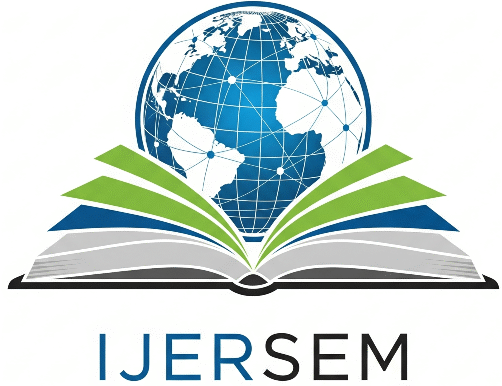International Journal of Emerging Research in Science, Engineering, and Management
Vol. 1, Issue 3, pp. 16-19, September 2025.
This work is licensed under a Creative Commons Attribution 4.0 International License.
Modeling Antimicrobial Resistance Spread in Riverine Ecosystems: A Multidisciplinary Approach
B. Jhansi
Assistant Professor, Siddharth Institute of Engineering & Technology, Puttur, Andhra Pradesh, India
Abstract: The rise of antimicrobial resistance (AMR) among critical pathogens poses an escalating threat to human, animal, and environmental health. Riverine ecosystems serve as major reservoirs and conduits for the dissemination of AMR due to diverse anthropogenic pressures including wastewater discharge, agricultural runoff, and industrial pollution. This study presents a multidisciplinary modeling framework integrating metagenomic data, chemical contaminant analyses, hydrological simulations, and social-ecological insights to elucidate AMR spread dynamics in riverine environments. The framework incorporates One Health principles, emphasizing the interconnectedness of ecosystem and public health factors. Results reveal significant contributions of ESKAPEE pathogens and co-selective contaminants, such as triclosan and heavy metals, to resistome proliferation. Seasonal hydrological changes modulate the transport of ARGs, and community behaviors influence exposure patterns. The model provides actionable insights for targeted interventions aimed at mitigating AMR risks in aquatic ecosystems, advancing environmental and public health security.
Keywords: Antimicrobial Resistance, Riverine Ecosystems, Modeling, Multidisciplinary Approach, Pathogens, Environmental Contaminants, Resistome, Hydrological Modeling, Social Mapping.
References:
- R. Samson, M. Dharne, and K. Khairnar, “Bacteriophages status quo and emerging trends toward one health approach,” The Science of the Total Environment, vol. 908, p. 168461, Nov. 2023, doi: 10.1016/j.scitotenv.2023.168461.
- D. Agarwal, K. Sharma, H. D. Chaudhary, U. Bhatt, and V. Soni, “Comprehensive insights into Triclosan environmental sources, plant uptake, metabolism, phytotoxicity, and food safety risks,” Next Sustainability, vol. 6, p. 100147, Jan. 2025, doi: 10.1016/j.nxsust.2025.100147.
- V. K. Nathan, S. Mohan, J. Vijayan, M. H. Abdulla, and P. Ammini, “An overview of the metagenomics-based assessment of ecosystem toxicology,” in Elsevier eBooks, 2024, pp. 367–382, doi: 10.1016/b978-0-323-91631-8.00009-3.
- L. S. J. Cook et al., “Microbial, holobiont, and Tree of Life eDNA/eRNA for enhanced ecological assessment,” Trends in Microbiology, Aug. 2024, doi: 10.1016/j.tim.2024.07.003.
- L. Manikam et al., “CHIP toolkit social mapping and transect walk for childhood infection and pollution — a comparative study across four cities,” One Health, vol. 21, p. 101126, Jul. 2025, doi: 10.1016/j.onehlt.2025.101126.
- Z. Yang et al., “Source-oriented ecological and resistome risks associated with geochemical enrichment of heavy metals in river sediments,” Chemosphere, vol. 336, p. 139119, Jun. 2023, doi: 10.1016/j.chemosphere.2023.139119.
- S. S. Ali et al., “Microplastics and their ecotoxicological impacts: remediation approaches, challenges and future perspectives – a review,” Journal of Cleaner Production, vol. 452, p. 142153, Apr. 2024, doi: 10.1016/j.jclepro.2024.142153.
- M. Ayaz et al., “Microplastics transport and impact on nitrogen cycling and N2O emissions in estuaries,” Environmental Pollution, p. 126869, Jul. 2025, doi: 10.1016/j.envpol.2025.126869.
- J. L. Valdespino and L. García-García, “Cholera environmental risk factors,” in Elsevier eBooks, 2011, pp. 616–623, doi: 10.1016/b978-0-444-63951-6.00389-2.
- H. Cui et al., “Pollution distribution characteristics and ecological risks of typical emerging chemical contaminants in aquatic environments,” in Elsevier eBooks, 2024, pp. 1–20, doi: 10.1016/b978-0-443-14170-6.00033-0.
- B. C. O’Kelly et al., “Microplastics in soils: an environmental geotechnics perspective,” Environmental Geotechnics, vol. 8, no. 8, pp. 586–618, Mar. 2021, doi: 10.1680/jenge.20.00179.
- R. Nazir, M. R. Zaffar, and I. Amin, “Bacterial biofilms,” in Elsevier eBooks, 2019, pp. 307–340, doi: 10.1016/b978-0-12-817495-1.00008-6.
